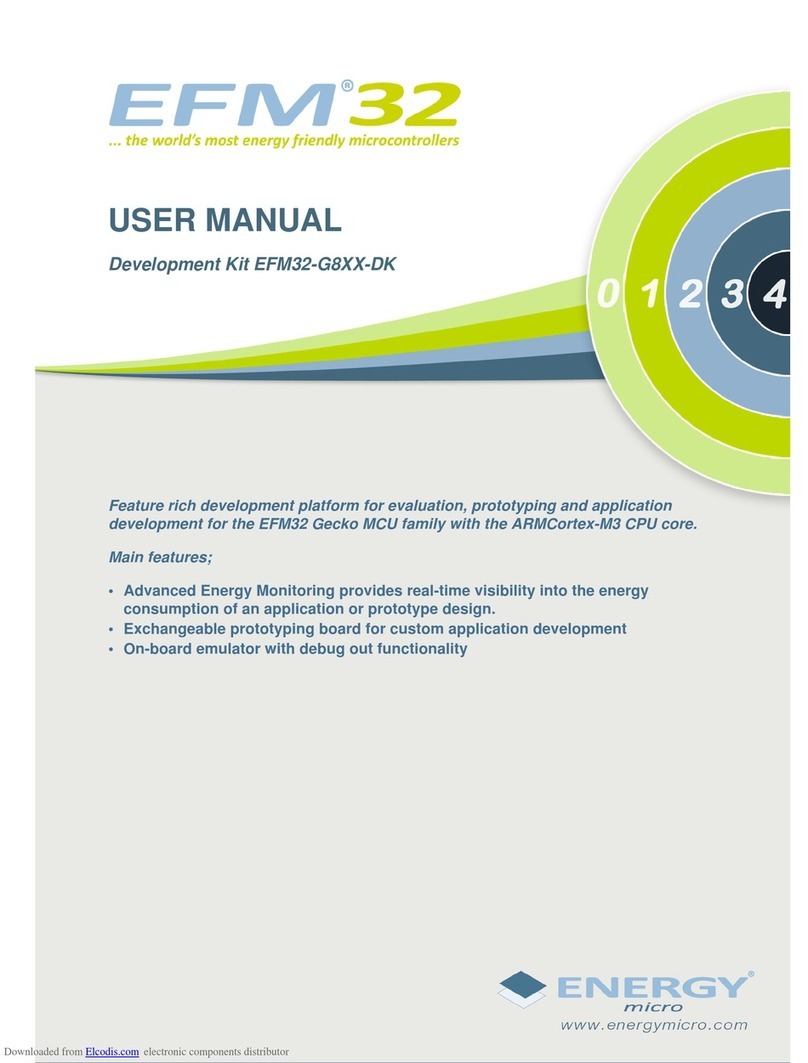Preliminary ...the world's most energy friendly microcontrollers
2010-04-09 - t0006_1.10 8 www.energymicro.com
The peripheral is connected directly to the EFM when the AUDIO_IN bit in the PERCTRL register in the
board controller has been set.
6.8 Line Out / Audio out
This is an audio output amplifier with filter, and the input connects to the DAC of the EFM. The gain of
the amplifier is 6 dB and is referenced to ground. The filter is a 3-pole linear phase MFB filter with a
cutoff frequency (at -3 dB) is at 27 kHz.
The peripheral is connected directly to the EFM when the AUDIO_OUT bit in the PERCTRL register in
the board controller has been set.
6.9 RS232
There are two RS232 connectors on the board which connects to the USART and LEUART of the EFM.
TheRS232 driver runsat 3.3 Vand it isrecommendedthat theMCUvoltage is 3.3V as well.Unpredicted
behavior can occur if the MCU voltage is much lower than 3.3V and the RS232 driver is enabled.
The two RS232 drivers can be connected to the EFM individually by setting the RS232_A and RS232_B
bits in the PERCTRL register in the board controller. The RS232_SHUTDOWN bit must also be cleared.
Note When none of the RS232 drivers are in use, it is highly recommended that the driver is shut
down by setting the RS232_SHUTDOWN bit in the PERCTRL register.
6.10 Accelerometer
This is a 3-axis accelerometer that connects to the ADC of the EFM. It outputs voltages proportional
to the g-forces for each axis. There are two settings for the range. If ACCEL_GSEL in the PERCTRL
register is cleared, the range is from 0 to 1.5 g, and when the bit is set the range is from 0 to 6 g.
The peripheral is connected directly to the EFM when the ACCEL bit in the PERCTRL register in the
board controller has been set.
6.11 IrDA
This is a 115.2 kBit/s (SIR) IrDA transceiver with a range of up to 70 cm, and connects to the USART
of the EFM.
The peripheral is connected directly to the EFM when the IRDA bit in the PERCTRL register in the board
controller has been set.
6.12 Potmeter
This is a potmeter pulled to 3.3 V by a 10k resistor, and it is connected to the ADC of the EFM. Using
the potmeter the output of this peripheral can be adjusted from 0 V to 3 V.
The peripheral is connected directly to the EFM when the POTMETER bit in the PERCTRL register in
the board controller has been set.
6.13 Ambient light sensor
This is an LDR in series with a 10k resistor, and it is connected to the ADC of the EFM. The output
voltage of the sensor ranges from 0.1 V to 2 V, increasing with the amount of light.
The peripheral is connected directly to the EFM when the AMBIENT bit in the PERCTRL register in the
board controller has been set.




























